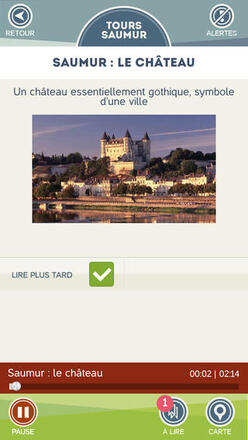
06/03/2025
[Fr] Décès de Philippe Auclerc
C'est avec tristesse que nous avons appris aujourd'hui le décès de Philippe Auclerc, co-fondateur de la maison d'édition "Loire et terroirs" et rédacteur...
Published on 11 April 2014 - Updated 22 May 2014
Cet article date d'il y a plus de 10 ans
An innovative travelling companion, the first version of this discovery guide is designed for users of the Tours-Saumur line. Your smartphone becomes an aid to making fresh discoveries, with georeferenced audio content and alerts as you approach points of interest to encourage you to take a closer look at the passing landscape and facilitate your understanding of it. A second level comprises 13 complements with texts and pictures to enrich your discovery experience, while a third level provides tourist and orientation information (“Loire à Vélo”, and local and tourist information) relating to railway stations along the line. On the train, the application acts as a guided tour, but can also be used as an aid to self-guided tours, whether you’re on board the train or not.
The app was developed by Mission Val de Loire on behalf of the Centre and Pays de la Loire Regions and in partnership with the SNCF.
It is available free of charge from AppStore (IPhone) and Google Play (Android).
Other lines will be included soon, as well as an English language version:
Among others, geographers, heritage curators, market gardeners and stone dressers invite you to share their passion for what makes the Loire Valley a cultural landscape recognised by UNESCO: its châteaux, its towns and villages, the river, its layout and the ways in which its space is used.
The idea is to make use of the cultural landscape’s heritages in order to present and explain them when they are visible to passers-by. Such prominent examples as Saumur and Chaumont spring immediately to mind, as well as urban centres and the towns of Blois, Beaugency, Meung-sur-Loire, the approach to Amboise, the Armorican Loire, the River Maine crossing or the Loire crossing near Montlouis and Langeais.
When the visual environment lacks immediate interest, content may also provide general cultural and heritage data relating to the Loire Valley, as well as, for example, information on the history and construction of the railway line or on the literary or pictorial heritages associated with the areas in question.

Ergonomically speaking, a behavioural, sensorial approach has been prioritised, designed to encourage users to look at and observe what they can see through the train windows. The smartphone acts as a guide and an accessory to discovery, with audio content when there is something interesting to see. Visual content is largely used at second levels of reading or for places that cannot be observed direct.